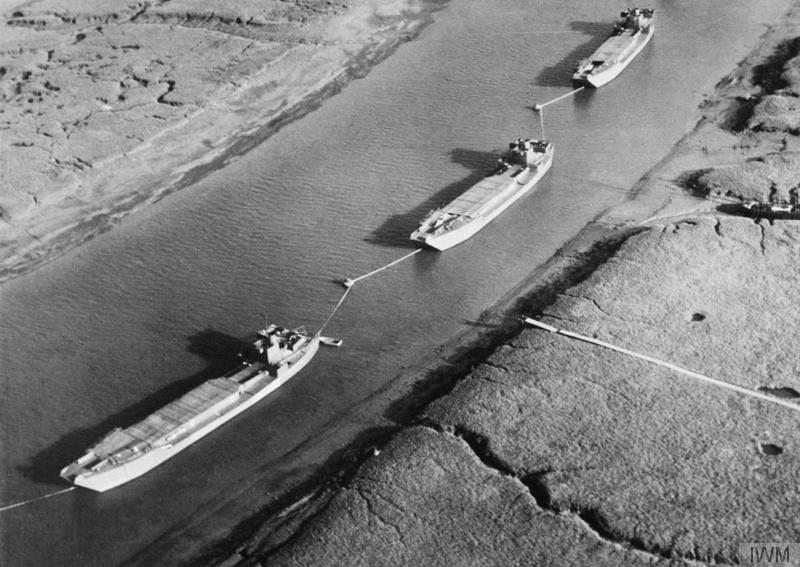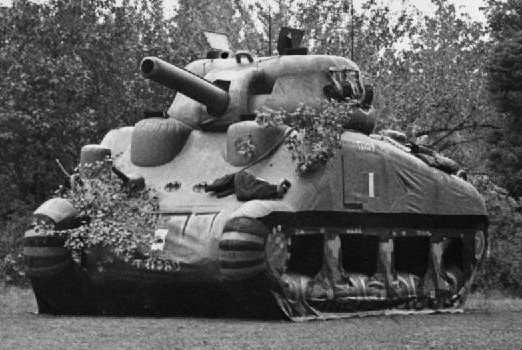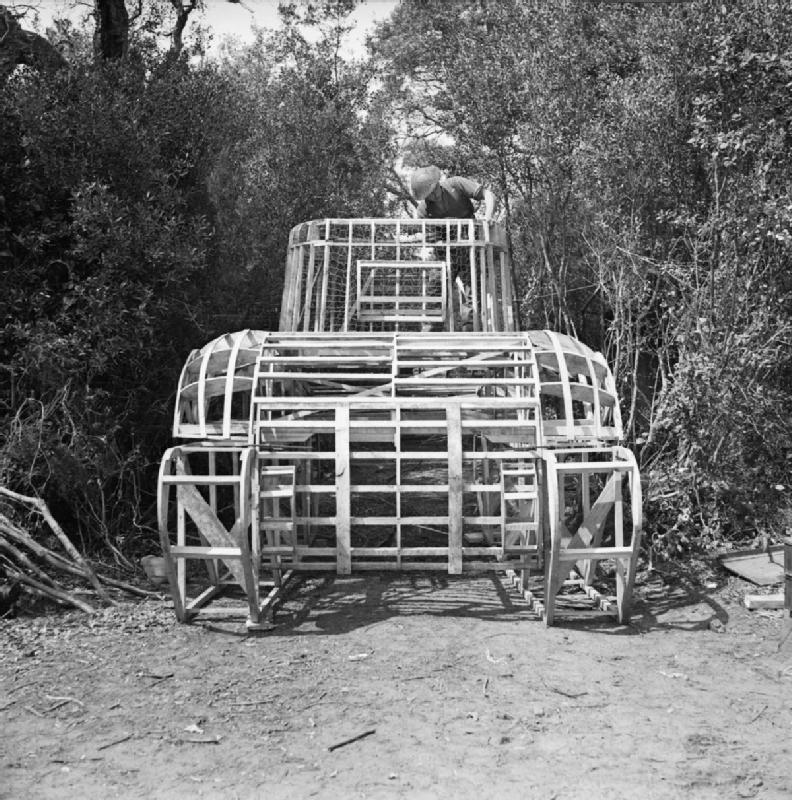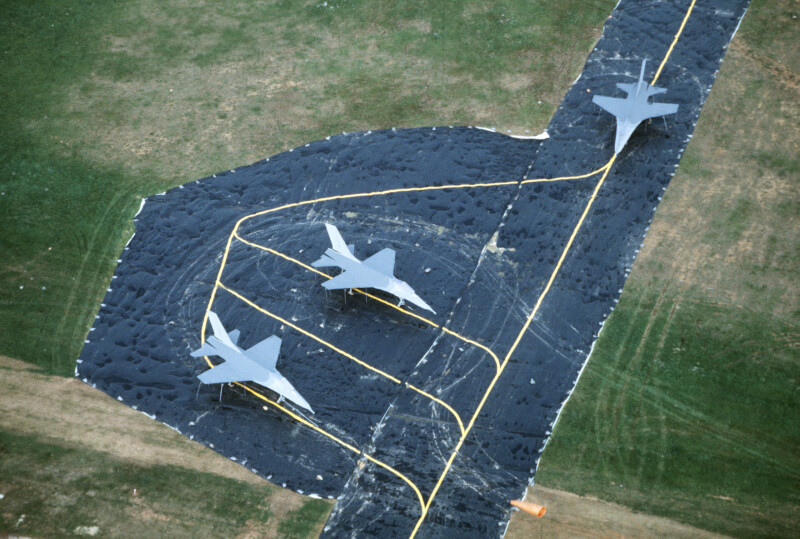
Dummy landing craft lie moored an unknown location in southeast England in the weeks before D-Day. [Credit: IWM/Wikimedia]
The drone video of a target parked next to a shed and partially hidden by vegetation is set to a heavy beat; shortly after, there’s an explosion and fire, followed by the guttural utterings of an evidently boastful narrator.
The Telegram channel Kremlin Pachka posted the video in early-June, lauding it as evidence of a Lancet drone strike on a Ukrainian tank near Krasnolimansky—Lyman to the Ukrainians who live there—in the country’s Donetsk Oblast.
The video went viral after Vladimir Solovyov, a top Russian TV propagandist, shared it with his 1.3 million followers.
Trouble is, the “tank” was a wooden decoy made from empty 155mm shell crates, said a laughing Ukrainian Lieutenant Commander Oleksandr Afanasyev, who posted his own video celebrating the apparent ruse erected at the site where he and his armoured troopers had lost a tank about a month before the attack.
Afanasyev provided verifying images to the online news site Insider, including before-and-after photographs of the wooden mock-up and the charred earth where it once stood. The site appears to be the same one as in the video. Insider reporters corroborated Afanasyev’s story with other Ukrainian sources.
Afanasyev suggested Solovyov should know better, alluding to a Russian idiom meaning to mislead others when he said: “This scoundrel’s job is to hang all sorts of rubbish on his ears. They fool their own people.”
Well, the Ukrainians certainly fooled them, employing a lesson from relatively recent history, as they have in other instances, to gain some measure of military advantage, however small.

An inflatable dummy tank was modelled after the M4 Sherman.
[U.S. Army/Wikimedia]
Operation Fortitude was a vast and complex ruse designed to lead the Germans to believe the expected Allied invasion of the continent would not land in Normandy—and that once landings did take place there, to delay Axis reinforcement by convincing the enemy that Normandy was merely a diversion.
They launched two deceptions, one in the south of England to suggest an invasion might come at Pas-de-Calais—the shortest route across the English Channel—and another in Scotland that appeared to point to Norway.
Deception techniques had already been used in North Africa in 1941-1942 and prior to the Sicily landings in 1943.
Fortitude drew on these techniques, using what had come to be referred to as “special means,” including combinations of physical deception, fake wireless (radio) activity, diplomatic and double agent “leaks,” and the use of notable officers in fake formations.
One of those double agents, Spaniard Juan Pujol García (Garbo), set up a fictional network of 27 agents across Britain to create the impression of additional formations. He was so trusted he was awarded the German Iron Cross and an MBE.
The Allies built temporary buildings and dummy landing craft were stationed at likely embarkation points in the east and the southeast of England. At holding areas, dummy tanks replaced real tanks when the latter were moved in preparation for the actual invasion, leading the Germans to think the Allies had more tanks than they did, as well as believing the invasion would come later.
When it actually did come, on June 6, 1944, the RAF dropped dummy parachutists to simulate an airborne invasion and draw German forces away from key objectives.

A dummy Sherman tank under construction by 6 Field Park Company, Royal Engineers, on the Anzio bridgehead, April 29, 1944. [Spittle/No. 2 Army Film & Photographic Unit/Wikimedia]
Protocols added to the Geneva Conventions in 1977 state that “ruses of war are not prohibited.”
Allied navies employed decoys through much of the war.
Famously, the First World War British battleship Centurion, obsolete and disarmed by 1939, spent two years in the Mediterranean fitted with wooden guns to make British naval forces in the area appear stronger than they were.
The ship was scuttled as a breakwater during the invasion of Normandy off Omaha Beach on June 9, 1944, to protect a Mulberry harbour built to supply the forces ashore.
Likewise, some British merchant ships were fitted with dummy structures to resemble warships.
Such deceptions, known by the French ruse de guerre—literally “ruse of war”—date to ancient times, from the Trojan Horse said to have been used by the Greeks at Troy to the Stars and Stripes of then-neutral America flown by the British ocean liner Lusitania to deter German submarine attacks (it didn’t work; Lusitania was torpedoed by U-20 on May 7, 1915, with the loss of 1,195 lives, including 123 Americans).
Such ruses have long been considered permissable by convention and under international law—a “just and necessary means of hositility” according to the 1863 Lieber Code, “permissable” in the 1913 Oxford Manual of Naval War, and “legitimate as long as they do not imply the recourse to treachery or perfidy” by the standards set in Argentina’s 1969 Law of War Manual.
Protocols added to the Geneva Conventions in 1977 state that “ruses of war are not prohibited.”
“Such ruses are acts which are intended to mislead an adversary or to induce him to act recklessly but which infringe no rule of international law applicable in armed conflict and which are not perfidious because they do not invite the confidence of an adversary with respect to protection under that law.”
It includes the use of camouflage, decoys, mock operations and misinformation.

Mockups of three U.S. Air Force F-16 Fighting Falcon aircraft are parked on a fake runway at Spangdahlem Air Base, Germany, during a 1985 exercise. [Wikimedia]
Advertisement





















